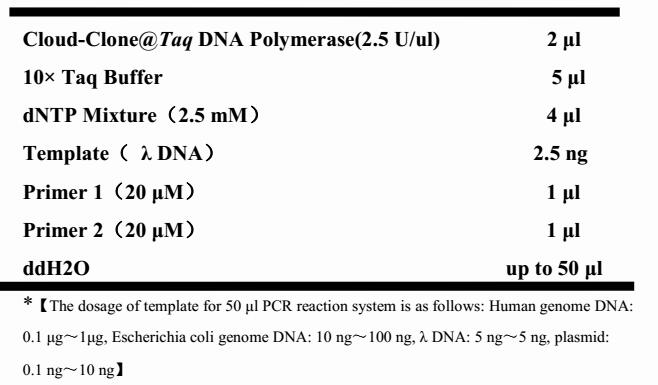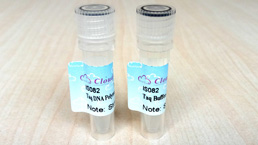Taq DNA Polymerase
Instruction manual
First Edition (Revised on April, 2016)
[PRODUCT INFORMATION]
Cloud-Clone@Taq DNA Polymerase is recombinant Taq DNA polymerase . It is purified from the cloned Thermus aquaticus DNA polymerase gene expressed in E. coli. The enzyme catalyzes the template-dependent polymerization of nucleotides into duplex DNA in the 5’-3’ direction. It has 3’-5’ exonuclease activity and excellent fidelity. The PCR product of 3' end contains A, it could be directly used for T/A cloning.
[REAGENTS AND MATERIALS PROVIDED]
Composition | IS082-1 | IS082-2 |
Cloud-Clone@Taq DNA Polymerase(2.5 U/ul) | 250U | 500U |
10×Taq Buffer | 2ml | 2ml |
[STORAGE AND PERIOD OF VALIDITY]
Store at -20℃. The Period of Validity is 1 year.
[DEFINITION OF ACTIVITY UNIT]
One unit of the enzyme catalyzes the incorporation of 10 nmol of deoxyribonucleotides into a polynucleotide fraction in 30 min at 72℃.
[QUALITY CONTROL]
Exogenous DNA endonuclease , exonuclease and RNase are free; Host residual DNA was not detected by PCR method. Single copy human gene can be effectively amplified using the enzyme.
[APPLICATION]
PCR amplification, DNA labeling, primer extension, sequencing, etc.
[PCR AMPLIFICATION CAPABILITY]
1.The DNA fragment of 20 kbp can be amplified by using λDNA as template.
2.The DNA fragment of 17.5 kbp (β-Globin gene) can be amplified well by using human genomic DNA as template.
[IMPORTANT NOTES]
1. PCR is a powerful tool for the determination of DNA, so must take appropriate measures to avoid crossing contamination. In order to avoid the other primer or template pollution PCR system, so must separate the area of analysis and reaction.
2. Because the enzyme has 3’-5’ exonuclease activity, primers and templates can be degraded without dNTP in PCR system. So the enzyme must be added in the final, and operated on an ice bath.
3.The PCR Buffer for Taq enzyme could not be replaced.
[PRACTICAL EXAMPLE]
Preparation of PCR reaction system (50μl)

2.PCR reaction condition
Using λ DNA as template to amplify 1 kbp and 16kbp DNA fragment of the PCR reaction conditions are as follows:





